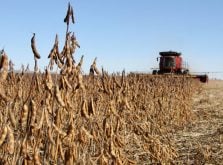DRAYTON VALLEY, Alta. – As a rural landowner Cliff Whitelock worries about the health of Alberta’s water supply as oil and gas activity increases.
“It is our next generation’s water supply we are using up,” said Whitelock, who ranches near Drayton Valley in west-central Alberta. He recently attended one of 13 ground water and coalbed methane sessions held in key areas of exploration and drilling.
While his region has experienced extensive oil and sour gas recovery, almost no coalbed methane drilling has started.
Whitelock is concerned about the loss of fresh water during enhanced oil recovery, a process that injects water into older wells to bring up oil. He also worries about possible contamination from coalbed methane wells where fracturing chemicals are used to break open coal seams to release the gas into pipelines.
Read Also

Manitoba extends Crown land rent freeze
Manitoba government links the continued rental rate freeze on grazing and forage leases to economic and environmental challenges facing the industry
All this activity could affect future land values if water is contaminated or lost.
“How can land be sold without water?”
Drayton Valley sits on the Ardley coal formation where fresh water is found in seams along with methane. Part of the formation, known as the Upper Ardley, contains water while the Lower Ardley appears dry because of an impenetrable layer of rock over the formation.
Oil and gas companies have drilled about 40 wells in the area but have delayed further activity until the provincial government writes firm policies to deal with the water.
A lack of firm government policies worries some, such as Liberal environment critic David Swann.
He charges the government has not done enough mapping of ground water resources in the province. Further, he said not enough is known about gas migration into water supplies.
Walter Ceroici of Alberta Environment said mapping is under way and about 200 of the province’s 500,000 water wells are monitored for contamination. The province plans to increase monitoring and is starting to make more detailed maps of coal seams and aquifers, he added.
As of May 1 the province ordered testing of all water wells that are 600 to 800 metres from proposed coalbed methane development.
The tests will include a two hour yield, routine water chemistry, bacteriological analysis and gas samples. They will assess free gas content versus dissolved gases. Dissolved gas can be variable and are difficult to measure. Exploration companies must provide the tests to Alberta Environment and the landowner.
A growing number of landowners are blaming coal seam fracturing and drilling for methane in their wells. However, Ceroici said most gas migration issues are related to well maintenance.
So far, there is no evidence of coalbed methane migrating. It is known that 26,000 water wells have been drilled through coal seams and about 900 are gassy.
“It is an issue that has been there before CBM even existed, Ceroici said.
However, the government and the University of Calgary are working to pinpoint shallow gas locations and the possibility of gas migration in water wells.
Ground water flows through pores and small fractures in the soil and rock. It moves slowly through rocks and quality is variable. It dissolves minerals such as calcium as it moves and may also take in gases such as methane, carbon dioxide, hydrogen sulfide, oxygen and nitrogen.
If a farmer believes a well has been damaged, restitution could be available to pay for repairs. However, landowners must properly maintain wells to keep out possible contaminants, said farmers’ advocate Jim Kiss.
“You have a responsibility to maintain your wells,” he said.
Farmers should keep records of a well’s test results and production levels for evidence if future problems arise.
Since 2001, exploration companies have drilled 6,000 coalbed methane wells with an investment of $2 billion. They plan more wells this year with a $1.5 billion investment.















